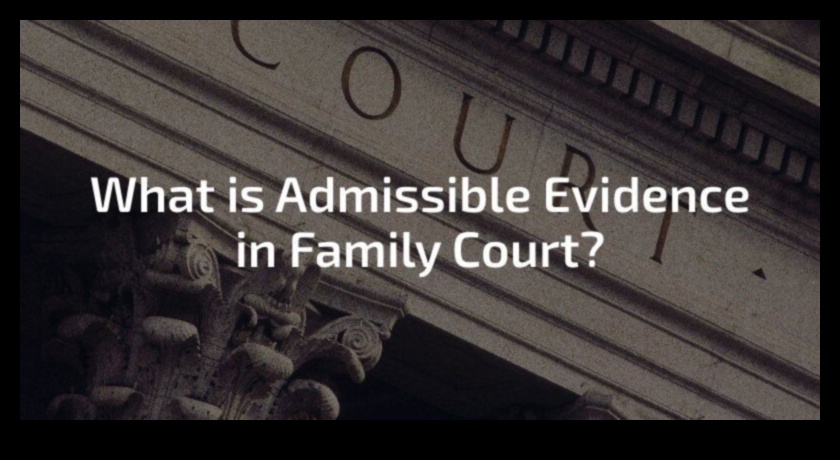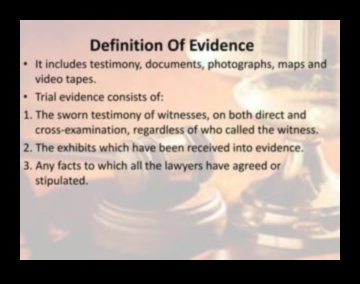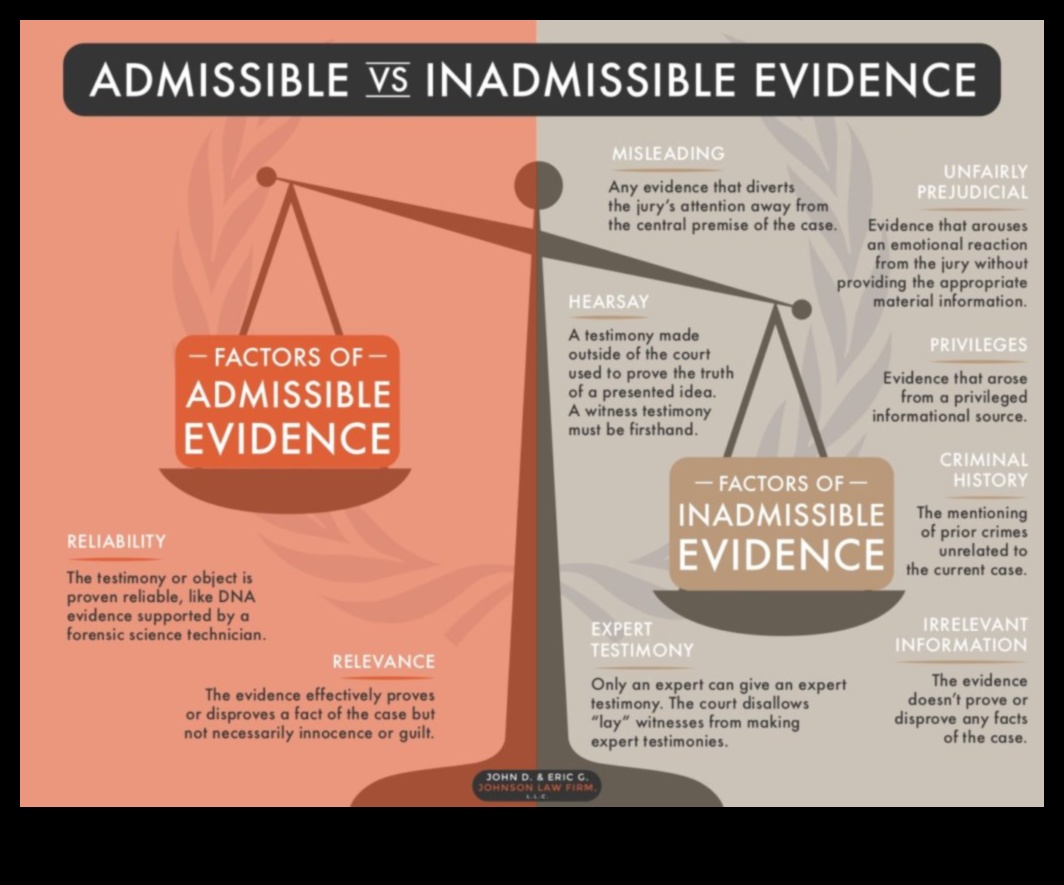
Admissible Evidence in Family Court
This article discusses the types of evidence that are admissible in family court. It covers hearsay evidence, demonstrative evidence, expert witness testimony, privileged communications, the burden of proof, the standard of proof, and objections to evidence.
Types of Evidence
The following are the types of evidence that are admissible in family court:
- Testimonial evidence
- Real evidence
- Documentary evidence
- Photographic evidence
- Audiovisual evidence
Hearsay Evidence
Hearsay evidence is a statement made by someone other than the witness who is testifying in court. Hearsay evidence is generally not admissible in court, but there are exceptions to this rule.
Demonstrative Evidence
Demonstrative evidence is evidence that is used to illustrate or explain a witness’s testimony. Demonstrative evidence can include photographs, diagrams, models, and other visual aids.
Expert Witness Testimony
Expert witness testimony is evidence given by a witness who has specialized knowledge or experience in a particular field. Expert witness testimony can be used to explain complex or technical evidence to the jury.
Privileged Communications
Privileged communications are communications that are protected from disclosure in court. Privileged communications include communications between a client and their attorney, and communications between a doctor and their patient.
The Burden of Proof
The burden of proof is the responsibility of the party who is alleging a fact to prove that fact. In family court, the burden of proof is usually on the plaintiff.
The Standard of Proof
The standard of proof is the level of proof that is required to establish a fact. In family court, the standard of proof is usually preponderance of the evidence.
Objections to Evidence
An objection is a statement made by a party in a trial to prevent the introduction of evidence. There are a number of different types of objections that can be made to evidence, including objections to hearsay evidence, objections to demonstrative evidence, and objections to expert witness testimony.
FAQ
- What is the difference between testimonial evidence and real evidence?
- What are the exceptions to the hearsay rule?
- What is demonstrative evidence?
- What is expert witness testimony?
- What are privileged communications?
- What is the burden of proof?
- What is the standard of proof?
- What are the different types of objections that can be made to evidence?
| Topic | Answer |
|---|---|
| Admissible Evidence in Family Court | Evidence that is relevant and material to the case at hand and is not otherwise barred by law is admissible in family court. |
| Types of Evidence | The types of evidence that are admissible in family court include: |
| Hearsay Evidence | Hearsay evidence is not admissible in family court unless it falls under one of the exceptions to the hearsay rule. |
| Demonstrative Evidence | Demonstrative evidence is admissible in family court to help the judge or jury understand the evidence or to prove a fact in issue. |
| Expert Witness Testimony | Expert witness testimony is admissible in family court to provide opinions on matters that are outside the knowledge of the average person. |
| Privileged Communications | Privileged communications are not admissible in family court. |
| The Burden of Proof | The burden of proof is on the party who is alleging the fact in issue. |
| The Standard of Proof | The standard of proof in family court is a preponderance of the evidence. |
| Objections to Evidence | A party can object to the admission of evidence if it is not relevant, material, or otherwise admissible. |
| FAQ | Q: What is the difference between admissible evidence and relevant evidence? |
| A: Admissible evidence is evidence that is relevant and material to the case at hand and is not otherwise barred by law. Relevant evidence is evidence that tends to prove or disprove a fact in issue. | |
| Q: What are the exceptions to the hearsay rule? | |
| A: The exceptions to the hearsay rule include: | |
| 1. Present sense impression | |
| 2. Excited utterance | |
| 3. Then-existing mental, emotional, or physical condition | |
| 4. Statements for purposes of medical diagnosis or treatment | |
| 5. Business records | |
| 6. Public records | |
| 7. Absence of a record | |
| 8. Dying declaration | |
| Q: What is the burden of proof in family court? | |
| A: The burden of proof in family court is a preponderance of the evidence. This means that the party who is alleging the fact in issue must show that it is more likely than not that the fact is true. | |
| Q: What is the standard of proof in family court? | |
| A: The standard of proof in family court is a preponderance of the evidence. This means that the party who is alleging the fact in issue must show that it is more likely than not that the fact is true. |

II. Types of Evidence
There are many different types of evidence that can be admitted in family court, including:
- Testimonial evidence
- Documentary evidence
- Physical evidence
- Expert witness testimony
- Other types of evidence
Each type of evidence has its own rules and procedures for admissibility, and the judge will determine whether or not the evidence is relevant and reliable before it can be presented to the jury.
Testimonial evidence is the most common type of evidence presented in family court, and it consists of the testimony of witnesses who are called to the stand to give their firsthand accounts of the events in question.
Documentary evidence is any written or printed material that can be used to prove a fact or establish a claim, such as contracts, letters, emails, and medical records.
Physical evidence is any tangible object that can be used to prove a fact or establish a claim, such as weapons, drugs, or clothing.
Expert witness testimony is the testimony of a person who has specialized knowledge or experience in a particular field and can provide the court with an opinion on a matter that is outside the knowledge of the average juror.
Other types of evidence that may be admissible in family court include photographs, videos, audio recordings, and computer records.
III. Hearsay Evidence
Hearsay evidence is an out-of-court statement that is offered in court to prove the truth of the matter asserted. Hearsay evidence is generally not admissible in family court, but there are some exceptions.
One exception to the hearsay rule is when the statement is made by a party to the case or their agent. For example, if a husband testifies that his wife told him that she was going to file for divorce, this testimony would be admissible as an exception to the hearsay rule.
Another exception to the hearsay rule is when the statement is made by a witness who is unavailable to testify at trial. For example, if a witness is deceased or out of the country, their testimony may be admitted as hearsay evidence.
The hearsay rule is designed to prevent unreliable evidence from being admitted in court. However, the exceptions to the rule allow for the admission of hearsay evidence when it is necessary to prove a fact that is otherwise unavailable.

IV. Demonstrative Evidence
Demonstrative evidence is evidence that is used to illustrate or explain something. It can be used to help the jury understand a complex concept or to show how something happened. Demonstrative evidence can take many forms, such as:
- Charts and graphs
- Photographs
- Videotapes
- Models
- Audio recordings
In order to be admissible, demonstrative evidence must be relevant and helpful to the case. It must also be accurate and not misleading. The judge will decide whether or not to admit demonstrative evidence based on these factors.
Demonstrative evidence can be a powerful tool in a trial. It can help the jury understand the evidence and come to a fair verdict. However, it is important to use demonstrative evidence responsibly and only when it is truly helpful to the case.

V. Expert Witness Testimony
Expert witness testimony is a type of evidence that is presented by a person who has specialized knowledge or experience in a particular field. Expert witnesses are typically called upon to testify about their opinions on matters that are outside the knowledge of the judge or jury.
In order to be admissible, expert witness testimony must meet certain criteria. First, the expert witness must be qualified to testify about the subject matter at issue. This means that the expert must have the necessary education, training, and experience to be considered an expert in the field. Second, the expert witness’s testimony must be relevant to the case. This means that the testimony must be helpful to the trier of fact in understanding the evidence or determining a fact in issue. Third, the expert witness’s testimony must be reliable. This means that the expert’s opinion must be based on sound scientific principles and methodology.
If the expert witness testimony meets these criteria, it will be admissible in court. However, the opposing party may still challenge the testimony by cross-examining the expert witness and presenting evidence that contradicts the expert’s opinion.
Expert witness testimony can be a valuable tool for presenting evidence in a family law case. By providing the court with expert opinions on matters such as child custody, child support, and alimony, expert witnesses can help the judge or jury make informed decisions about these important issues.

VI. Privileged Communications
Privileged communications are communications that are protected from disclosure in court. There are two types of privileged communications:
- Attorney-client privilege
- Doctor-patient privilege
Attorney-client privilege protects communications between a client and their attorney. This privilege applies even if the communication is made in the presence of a third party, such as a witness or a paralegal.
Doctor-patient privilege protects communications between a patient and their doctor. This privilege applies even if the communication is made in the presence of a third party, such as a nurse or a medical assistant.
Privileged communications are important because they allow people to speak freely with their attorneys and doctors without fear that their conversations will be disclosed in court. This allows for open and honest communication, which is essential for providing legal and medical advice.
VII. The Burden of Proof
The burden of proof is the responsibility of the party who is alleging that something is true. In a family law case, the party who is filing the lawsuit (the plaintiff) has the burden of proving their case by a preponderance of the evidence. This means that they must show that it is more likely than not that the facts they are alleging are true.
The defendant does not have to prove anything. They simply have to raise a reasonable doubt about the plaintiff’s evidence. If the jury has a reasonable doubt about the plaintiff’s evidence, they must find for the defendant.
The burden of proof is an important concept in family law because it determines who has the responsibility of proving their case. It is also important to remember that the burden of proof is always on the plaintiff, and the defendant does not have to prove anything.
The Standard of Proof
The standard of proof in family court is the same as the standard of proof in criminal court: beyond a reasonable doubt. This means that the evidence presented by the prosecution must be so convincing that it leaves no reasonable doubt in the mind of the judge or jury that the defendant is guilty.
In family court cases, the standard of proof is often lower than it is in criminal court. This is because the stakes are lower in family court cases. In a criminal case, the defendant is facing the possibility of going to prison. In a family court case, the defendant is facing the possibility of losing custody of their children or having their visitation rights restricted.
As a result, the standard of proof in family court cases is often based on the preponderance of the evidence. This means that the evidence presented by the prosecution must be more convincing than the evidence presented by the defense. If the judge or jury believes that the evidence presented by the prosecution is more convincing, then they will find the defendant guilty.
The standard of proof is an important concept in family court cases. It helps to ensure that only those defendants who are truly guilty are found guilty. It also helps to protect the rights of defendants who are accused of crimes.
IX. Objections to Evidence
An objection to evidence is a formal request to the judge to exclude certain evidence from being presented at trial. Objections can be made for a variety of reasons, such as:
- The evidence is irrelevant to the case
- The evidence is hearsay
- The evidence is privileged
- The evidence is unduly prejudicial
- The evidence is cumulative
If an objection is sustained, the judge will exclude the evidence from being presented at trial. If the objection is overruled, the evidence will be admitted into evidence.
It is important to note that objections to evidence are only made during trial. They cannot be made before trial or during the pre-trial discovery process.
If you are involved in a family law case, it is important to speak to your attorney about the types of evidence that are admissible in family court and the types of objections that can be made to evidence.
X. FAQ
Q: What is admissible evidence in family court?
A: Admissible evidence in family court is any evidence that is relevant and material to the case and is not otherwise excluded by law.
Q: What are the different types of evidence?
A: The different types of evidence include:
- Testimonial evidence
- Documentary evidence
- Physical evidence
- Expert witness testimony
Q: What is hearsay evidence?
A: Hearsay evidence is a statement made by someone other than the witness who is testifying, and is offered to prove the truth of the matter asserted. Hearsay evidence is generally inadmissible in family court, except in certain circumstances.